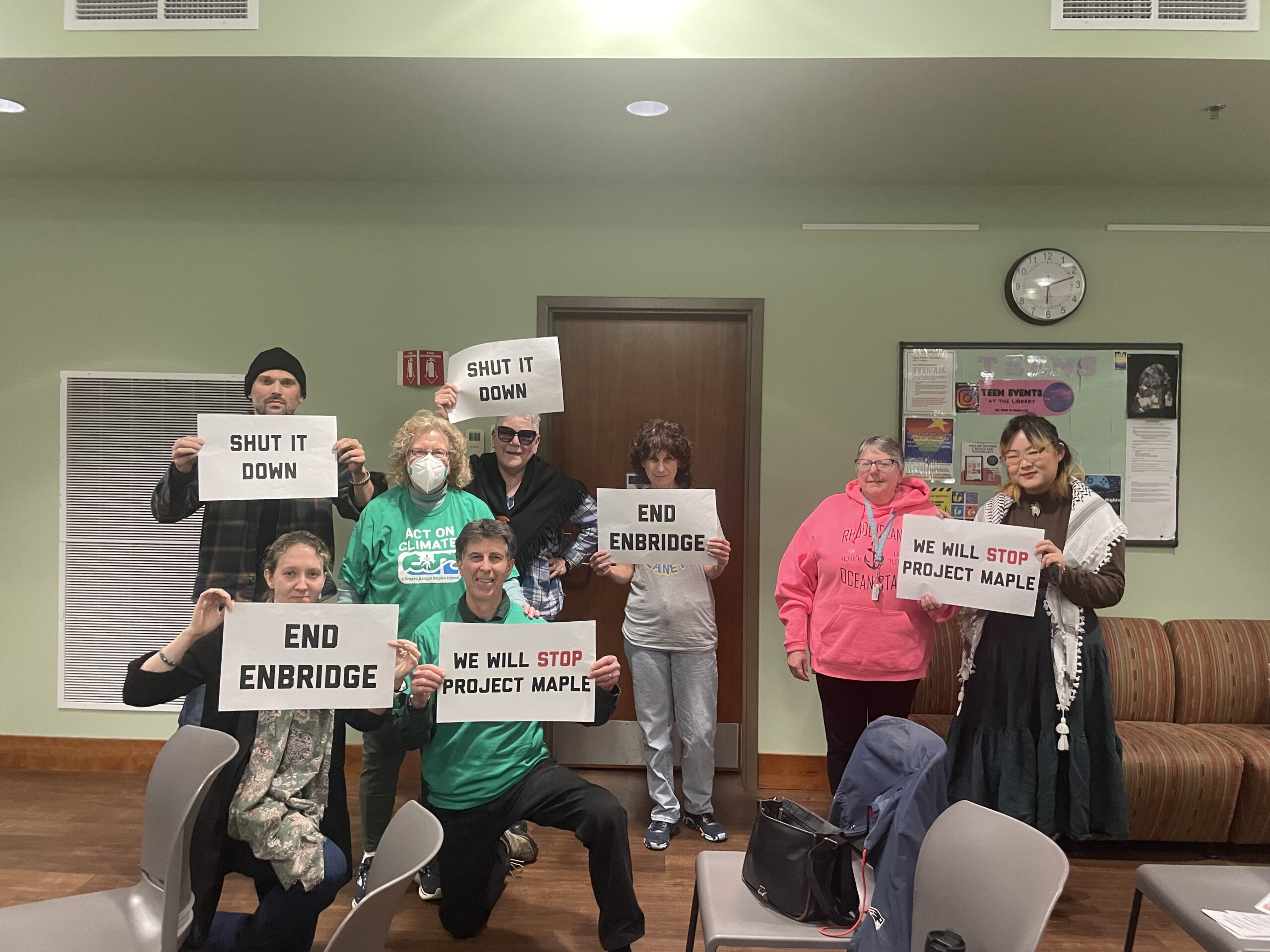Delays Push Burrillville Power Plant Toward Irrelevance
July 17, 2017
BURRILLVILLE, R.I. — A final round of public hearings for the proposed fossil fuel power plant starts in mid-October, but there has been plenty of activity in recent days related to the $1 billion natural gas/diesel facility.
The lengthy struggle to find a water supply recently prompted Invenergy Thermal Development LLC to declare that it will not start generating power by June 1, 2019. That’s the date that the operator of the regional power grid, ISO New England, agreed to start taking electricity from one of the two proposed 485-megawatt natural gas generators at the proposed Burrillville power plant.
But the fate of the Clear River Energy Center won’t be determined until around January — and construction is expected to take more than two years. Thus, in a June 30 report, Chicago-based Invenregy announced it’s pushing the start date off until June 1, 2020.
The delay was expected as Invenergy received two extensions from the state Energy Facility Siting Board (EFSB) to find a water supply to cool its nearly 1,000-megawatt plant. Burrilville and Woonsocket both said no to offering water to Invenergy, before Johnston agreed to sell the facility water.
Invenergy sold its 2019 obligation to generate that electricity through an annual reconfiguration auction to another power plant in New England. The buyer and the payment hasn’t been released by ISO New England.
The delay is good news to opponents of the power plant who see any holdup as an opportunity for renewable energy to match the capacity of the power plant and thereby render the Burrillville facility unnecessary.
“With each additional passing year, Invenergy is needed less and less,” said Jerry Elmer, senior attorney with the Conservation Law Foundation (CLF). “That is because the New England states are collectively acquiring significant quantities of new renewable-energy resources.”
Motion to dismiss
On July 13, the town of Burrillville filed its third motion to dismiss Invenergy’s application before the EFSB. As with the previous motions, Burrillville argues that Invenergy has exceeded the time limit to complete its application. Specifically, plans for the 55 structures slated for the site are either incomplete or unsubmitted, according to the motion. Those plans require review by the town building inspector and others.
“The town submits that Invenergy has already had 20 months to produce ‘complete plans for all structures’ and to ‘remedy the lack of compliance’ but has hailed to do so,” according to the complaint.
The motion to dismiss will likely not be considered by the EFSB for several weeks.
Already ongoing is a Supreme Court lawsuit by CLF and the town of Burrillville contesting the validity of the agreement that allows Johnson to sell water to Invenergy. Oral arguments in that case are expected Aug. 24.
Good humor man
Despite what’s at stake by building Rhode Island’s largest power plant, there is still room for humor. In response to Invenergy appointing its top attorney, Michael Blazer, from its headquarters in Chicago to its legal team in Providence, Elmer filed the following tongue-in-cheek response with the state Supreme Court, the court that determines if lawyers can participate in a single case without passing the bar in that state:
“Since October 2015, Invenergy has had only six lawyers (including four partners) from two Rhode Island law firms (including one of the state’s largest firms) litigating all alone against CLF, a non-profit, public-interest environmental law organization. Of course Invenergy wants more lawyers.”
Elmer also wrote in an email to the media and interested parties, “Even if Invenergy hires an army of lawyers, they will find it impossible to make a convincing case in favor of paving over a forest in order to build a diesel oil and fracked gas power plant in rural Burrillville.”
CLF and the Burrillville have three lawyers opposing the power plant.
Categories
Join the Discussion
View CommentsRecent Comments
Leave a Reply
Related Stories
Your support keeps our reporters on the environmental beat.
Reader support is at the core of our nonprofit news model. Together, we can keep the environment in the headlines.
We use cookies to improve your experience and deliver personalized content. View Cookie Settings




As Governor Wall St Raimondo lives on a hill she does not mind drowning those along the coast.
Good article summarizing the current state of the power plant story. We all stand behind Jerry Elmer and hope that his speculation becomes prophecy.
Meanwhile, ecori news does need a better map, and with it, perhaps, some additional inquiry.
The map displayed shows the Douglas and Quaddick state forests in bordering Ma and Ct, but fails to show, on the Rhode Island side of the borders, the Buck Hill Wildlife Management Area, and the George Washington-Pulaski Wildlife Management and Recreation Area. The Invenergy power plant will be built on the northern property line of George Washington-Pulaski. And between that 4,000 acre forest and the Buck Hill WMA is also located the Narragansett Council Boy and Cub Scout Reservation, which includes one of the most rare and critical habitats in the state, Cedar Swamp Pond. Add the Scout land to the total of six state-owned forests on all sides of the tri-state border, and you have over 25 square miles of contiguous, highly valued conservation and recreation land threatened by the Invenergy project. When Keep Road Island Beautiful recently posted a satellite photo-map displaying all these assets, over 1,200 people shared it. As the old saw goes, a picture is worth…
Obviously, a major industrial facility in this location would make a mockery of the norms that have governed land-use in Rhode Island since a series of epic battles over energy facility proposals for Narragansett Bay in 1970’s founded the modern environmental movement in our state. And the legal precedent the approval of Invenergy would etch into case law would threaten protected public lands in our state far into the future—including those we consider sacrosanct along the Bay and south coastline.
This power plant decision isn’t just an "issue," it is a crisis.
Particularly worrisome is the fact, so far, that while the Town of Burrillville is fighting the plant on various procedural questions, and the Conservation Law Foundation is fighting the plant on the question of its its need and its compliance with climate change legislation, and both are fighting the plant over the question of the Johnston water deal, no legal challenge has yet been mounted on the basis of state and local land-use precedent and law, and the terrestrial environmental impact of the plant on this highly valued forested region.
That should make us all really, really nervous.
The last time this piece of land, the Invenergy site, was considered as a power plant site was in 1987 when it was proposed as one of the alternatives to the Ocean State Power company’s "preferred" site six miles east, tucked against the Uxbridge, Ma, border.
The EFSB, brand new then and feeling full weight of its responsibility, invited the Federal Energy Regulatory Commission to conduct an formal Environmental Impact Statement. This generated powerful, outspoken testimony against the Invenergy site—the so-called "Buck Hill Road site"—for its glaring proximity to the conservation and outdoor recreational lands here enumerated, along with their extensive inventory of rare and threatened species and habitats.
But in the formal judicial proceedings of the Invenergy case today, no voice for the defense of these lands and those inventories has yet been mounted.
We can only hope that the Town of Burrillville, or CLF, or SOMEONE, is holding this card for later play.